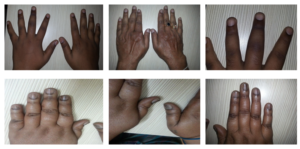
Image type: Asymmetric dactylitis of psoriasis
Body site: Fingers
Description: Dactylitis is common among patients with psoriatic arthritis. It most often affects the feet in an asymmetrical distribution. The affected areas are associated with greater radiological damage than the digits unaffected by dactylitis. Although there are no widely accepted criteria for the diagnosis or classification of this type of arthritis, the diagnosis is made easier in a patient with the typical features of the disease including involvement of distal interphalangeal joints, asymmetrical distribution, the presence of spondyloarthropathy, or the presence of inflammation of the whole digit (dactylitis).
Dactylitis, commonly referred to as the ‘sausage digit,’ has long been recognized as one of the cardinal features of psoriatic arthritis, affecting up to 40% of patients. It is frequently observed in spondyloarthropathies, particularly reactive arthropathies. While dactylitis may also manifest in conditions such as gout, sarcoidosis, flexor sheath infections, and sickle cell disease, it is exceptionally rare in rheumatoid arthritis. Ultrasound and magnetic resonance imaging (MRI) findings have indicated that dactylitis is primarily the result of inflammation of the digital flexor tendon sheaths.
Causes of dactylitis: The causes include psoriasis, tuberculosis, sickle cell anemia, gonococcal arthritis (type of infectious arthritis), sarcoidosis, leprosy, juvenile chronic arthritis, Reiter’s syndrome, and treponema pallidum.
Tuberculous dactylitis involves the short tubular bones of the hands and feet in children. It often follows a benign course without pyrexia and acute inflammatory signs as opposed to acute osteomyelitis.
Sickle dactylitis is one of the first ischemic complications in sickle cell syndromes with the highest incidence between ages six months and two years. About one-third to one-half of patients may experience this complication during early childhood but it is very rare in later life. This painful swelling of the dorsum of both hands and feet was the most common presenting symptom that led to diagnosis before newborn screening became common. Bone changes occurring during episodes of dactylitis can be caused by or mistaken for osteomyelitis.
Blistering distal dactylitis is a type of dactylitis or sausage fingers that occurs when there is inflammation of the pads of the finger. This condition is usually seen in children between six months to four years of age. This condition is quite painful and makes it difficult for the child to use the finger.
Diagnosis: To confirm a diagnosis of dactylitis, or sausage fingers, the treating physician typically begins by taking a detailed medical history to ascertain when the symptoms initially appeared. Following this, a thorough examination of the affected digits is conducted. The determination of the underlying cause involves performing blood tests to identify markers of inflammation or specific pathogens. Once the cause of the inflammation is pinpointed, the physician develops an appropriate treatment plan. For instance, if dactylitis is suspected alongside respiratory symptoms, a comprehensive lung examination may be conducted to rule out tuberculosis as a potential cause. If tuberculosis is confirmed, the physician then prescribes a course of antibiotics to address the underlying infection.
Treatment: The primary focus of treating dactylitis is to address the underlying cause, which is often associated with conditions such as sickle cell disease or psoriatic arthritis. Pain and inflammation can be alleviated by taking nonsteroidal anti-inflammatory drugs (NSAIDs). For cases where an autoimmune component is involved, disease-modifying antirheumatic drugs (DMARDs) may be recommended to manage the immune response and prevent further joint damage. Corticosteroid injections can provide localized relief for inflammation. Physical therapy can help to maintain joint flexibility and function. Biologic therapies that target specific immune pathways may be considered for severe cases or when conservative measures are ineffective. The approach to treating dactylitis is designed for each individual based on their underlying condition. Close collaboration between the patient and physician is vital for managing symptoms and improving overall quality of life.

You must be logged in to post a comment.